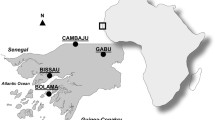Abstract
Although endemic goiter has been shown to have a high prevalence in Turkey, little is known about the concentration of urinary iodine, plasma selenium (Se), copper (Cu), and zinc (Zn) in these patients. We studied on 140 male patient with endemic goiter (mean age: 22.2 ± 0.19 yr) and 140 healthy male subjects (mean age: 21.8 ± 0.28 yr). Daily urinary iodine excretion was determined by the ionometric method. Plasma Se, Zn, and Cu were determined by using atomic absorption spectrometry. Daily urinary iodine excretion was found to be significantly lower in the patient group (38.7 ± 2.26 µg/d) than that of controls (50.73 ± 2.56 µg/day,p = 0.001). Plasma Zn concentrations were also found to be significantly lower in the patient group (1.04 ± 0.03 µg/mL) than that of controls (1.16 ± 0.02 µg/mL,p = 0.001). No significant difference was determined in Se and Cu concentrations between the patient and control groups. Our study shows that a moderate iodine deficiency exists in both patients with endemic goiter and control subjects, which indicates the important role of iodine deficiency in the etiopathogenesis of endemic goiter in Turkey. Zinc deficiency may also contribute to the pathogenesis of endemic goiter. However, Se and Cu do not seem to have any role in the etiopathogenesis of endemic goiter in Turkey. A community-based iodine fortification program throughout the country may be proposed to take over the problem, which also can prevent the contributing effects of other element deficiencies that occur when iodine deficiency is the prevailing factor.
Similar content being viewed by others
References
S. Kologlu and L. B. Kologlu, Iodine metabolisms in endemic goiter Turkey. I. The kinetics of 131-I an organic iodine,Biomedicine 19, 94–97 (1973).
H. Hatemi, I. Urgancioglu, O. Yenici, and H. Uslu,Türkiye’de Endemik Guvatr, Istanbul, Emel Matbaacilik. 38, (1988) (in Turkish).
O. Ozbakir, A Dogukan, and F. Kelestimur, The prevalence of thyroid dysfunction among elderly subjects in an endemic goiter area of central Anatolia,Endocr. J. 42, 713–716 (1995).
M. F. Erdogan and N. Kamel, Türkiye’nin de>gişjk cografi bölgelerinden gelen hastalarda ötiroid guvatr etiyolojisinde iyod eksikliginin yeri,Türkiye Klinikleri Tip Bilimleri Dergisi 16, 364–370 (1997) (in Turkish).
P. Goyens, J. Goldstein, B. Nsombola, H. Vis, and J. E. Dumont, Selenium deficiency as a possible factor in the pathogenesis of myxedematous endemic cretinism,Acta Endocrinol. 114, 497–501 (1987).
B. Contempre, J. E. Dumont, J. F. Denef, and M. C. Many, Effects of selenium deficiency on thyroid necrosis, fibrosis and proliferation: a possible role in myxoedematous cretinism,Eur. J. Endocrinol. 133, 99–109 (1995).
A. Kralik, K. Eder, and M. Kirchgessner, Influence of zinc and selenium deficiency on parameters relating to thyroid hormone metabolism,Horm. Metab. Res. 28, 223–226 (1996).
J. W. Oliver, D. S. Sachan, P. Su, and F. M. Applehans, Effects of zinc deficiency on thyroid function,Drug-Nutr. Interact. 5, 113–124 (1987).
J. G. G. Smith, D. Van der Heide, G. Van Tintelen, and A. C. Beynen, Thyroid function in rats with iodine deficiency is not further impaired by concurrent marginal zinc deficiency,Br. J. Nutr. 70, 585–592 (1993).
K. Aihara, Y. Nishi, S. Hatano, M. Kihara, K. Yoshimitsu, N. Takeichi, et al., Zinc, copper, manganese and selenium metabolism in thyroid disease,Am. J. Clin. Nutr. 40(1), 26–35 (1984).
D. K. Allen, C. A. Hassel, and K. Y. Lei, Function of pituitary-thyroid axis in copperdeficient rats,J. Nutr. 112, 1043–1046 (1982).
A. Kralik, M. Kirchgessner, and K. Eder, Concentrations of thyroid hormones in serum and activity of hepatic 5t’ monodeiodinase in copper-deficient rats,Z. Ernahrungswiss. 35, 288–291 (1996).
Y. Yabu, K. Miyai, Y. Endo, N. Hata, Y. Iijima, S. Hayashizaki, et al., Measurement of iodide in urine using the iodide-selective ion electrode,Endocrinol. Japan 33, 905–911 (1986).
M. B. Knowls and K. G. Brodie, Determination of selenium in blood by Zeeman graphite furnace atomic absorption spectrometry using a palladium ascorbic acid chemical modifier,J. Anal. Atomic Spectrom. 3, 511–516 (1988).
A. Luterotti, T. Svjetlana, S. Zanic, M. Tihana, and D. Juretic, Rapid and simple method for the determination of copper, manganese and zinc in rat liver by direct flame atomic absorption spectrometry,Analyst 117, 141–143 (1992).
G. J. Beckett, D. A. MacDougall, F. Nicol, and J. R. Arthur, Inhibition of type I and type II iodothyronine deiodinase activity in rat liver, kidney and brain produced by selenium deficiency,Biochem. J. 259, 887–892 (1989).
B. Corvilian, B. Contempre, A. O. Longombe, P. Goyens, C. Gervy-Decoster, F. Lamy, et al., Selenium and the thyroid: how the relationship was established,Am. J. Clin. Nutr. 57(Suppl.), 244S-248S (1993).
J. B. Vanderpas, B. Contempre, N. L. Duale, W. Goossens, N. Bebe, R. Thorpe, et al., Iodine and selenium deficiency associated with cretinism in northern Zaire,Am. J. Nutr. 52, 1087–1093 (1990).
J. B. Vanderpas, B. Contempre, N. L. Duale, H. Deckx, N. Bebe, A. O. Longombe, et al., Selenium deficiency mitigates hypothyroxinemia in iodine-deficient subjects,Am. J. Clin. Nutr. 57(Suppl.), 271S-275S (1993).
K. Menguba, N. A. Diab, O. Gokmen, O. Y. Ataman, A. Cavdar, and S. Cin, Selenium status of healthy Turkish children,Biol. Trace Element Res. 54, 163–172 (1996).
F. Hincal, N. Basaran, S. Yetgin, and O. Gokmen, Selenium status in Turkey. II. Serum selenium concentration in healthy residents of different ages in Ankara,J. Trace Element Electrolytes Health Dis. 8, 9–12 (1994).
F. Hincal, S. Yetgin, and N. Ataceri, Selenium status in Turkey. I. Serum selenium levels in infants and children in Ankara,Biol. Trace Element Res. 20, 161–167 (1989).
Author information
Authors and Affiliations
Rights and permissions
About this article
Cite this article
Ozata, M., Salk, M., Aydin, A. et al. Iodine and zinc, but not selenium and copper, deficiency exists in a male Turkish population with endemic goiter. Biol Trace Elem Res 69, 211–216 (1999). https://doi.org/10.1007/BF02783873
Received:
Revised:
Accepted:
Issue Date:
DOI: https://doi.org/10.1007/BF02783873




